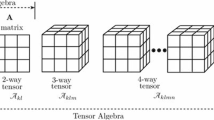Abstract
One of the most important challenges in the preparation and maintenance of databases such as face images is the presence of a large number of variables in the raw data. Reducing the size of each observation so that its features do not disappear and the co-signer uniquely provides dependence on the original data is a necessary requirement of functioning with databases. Principal component analysis and its improved methods are the common techniques for reducing the dimensionality of such datasets and simultaneously increasing the interpretability and minimizing information loss. In this paper, our purpose is to define one preprocessing step as nonuniform sampling to preserve raw data appearance and to increase the performance of the dimensional reduction methods. We use the properties of sparse principal component analysis to identify the the location of less important values of the raw data that do not interfere with data features. By using sparse eigenvectors, two algorithms are presented to remove redundancy from the raw data in the one-dimensional and two-dimensional cases. After removing raw data redundancy, newly obtained data in other applications such as database recognition and compression can be used. Simulation results show that using this preprocessing step reduces the memory amount and also provides the higher recognition rate.












Similar content being viewed by others
References
Lawrence, S., Giles, C.L., Tsoi, C., Back, A.D.: Face recognition: a convolutional neural-network approach. IEEE Trans. Neural Netw. 8(1), 98–113 (1997)
Turk, M., Pentland, A.: Eigenfaces for recognition. J. Cogn. Neurosci. 3(1), 71–86 (1991). https://doi.org/10.1162/jocn.1991.3.1.71
Jolliffe, I.T.: Principal Component Analysis and Factor Analysis, pp. 115–128. Springer, Berlin (1989)
Abdi, H., Williams, L.J.: Principal component analysis. Wiley Interdiscip. Rev. Comput. Stat. 2(4), 433–459 (2010)
Belhumeur, P.N., Hespanha, J.P., Kriegman, D.J.: Eigenfaces vs. fisherfaces: recognition using class specific linear projection. IEEE Trans. Pattern Anal. Mach. Intell. 19(7), 711–720 (1997)
Liu, Q., Lu, H., Ma, S.: Improving kernel fisher discriminant analysis for face recognition. IEEE Trans. Circuits Syst. Video Technol. 14(1), 42–49 (2004)
Roweis, S.T., Saul, L.K.: Nonlinear dimensionality reduction by locally linear embedding. Science 290(5500), 2323–2326 (2000)
Balasubramanian, M., Schwartz, E.L.: The isomap algorithm and topological stability. Science 295(5552), 7–7 (2002)
Belkin, M., Niyogi, P.: Laplacian eigenmaps and spectral techniques for embedding and clustering. In: Advances in Neural Information Processing Systems 14. Vancouver, British Columbia, Canada (2002)
He, X., Cai, D., Yan, S., Zhang, H.-J.: Neighborhood preserving embedding. In: 10th IEEE International Conference on Computer Vision, ICCV 2005, vol. 2, pp. 1208–1213 (2005)
Kokiopoulou, E., Saad, Y.: Orthogonal neighborhood preserving projections: a projection-based dimensionality reduction technique. IEEE Trans. Pattern Anal. Mach. Intell. 29(12), 2143–2156 (2007)
Zou, H., Hastie, T., Tibshirani, R.: Sparse principal component analysis. J. Comput. Graph. Stat. 15(2), 265–286 (2006). https://doi.org/10.1198/106186006X113430
Lai, Z., Wong, W.K., Xu, Y., Yang, J., Zhang, D.: Approximate orthogonal sparse embedding for dimensionality reduction. IEEE Trans. Neural Netw. Learn. Syst. 27(4), 723–735 (2016)
Yang, J., Zhang, D., Frangi, A.F., Yang, J.Y.: Two-dimensional PCA: a new approach to appearance-based face representation and recognition. IEEE Trans. Pattern Anal. Mach. Intell. 26(1), 131–137 (2006)
Xiao, C., Wang, Z.: Two-dimensional sparse principal component analysis: a new technique for feature extraction. In: 6th International Conference on Natural Computation, vol. 2, pp. 976–980 (2010)
Nojun, K.: Principal component analysis based on L1-norm maximization. IEEE Trans. Pattern Anal. Mach. Intell. 30(9), 1672–1680 (2008)
Zuo, W., Zhang, D., Wang, K.: Bidirectional PCA with assembled matrix distance metric for image recognition. IEEE Trans. Syst. Man Cybern. Part B (Cybern.) 36(4), 863–872 (2006)
Samaria, F.S., Harter, A.C.: Parameterisation of a stochastic model for human face identification. In: Proceedings of the 2nd IEEE Workshop on Applications of Computer Vision, pp. 138–142 (1994)
http://www.cs.columbia.edu/CAVE/software/softlib/coil-20.php
Larose, D.T.: Discovering Knowledge in Data: An Introduction to Data Mining, Chapter 5, k-Nearest Neighbor Algorithm, pp. 90–106. John Wiley & Sons (2005)
Author information
Authors and Affiliations
Corresponding author
Additional information
Publisher's Note
Springer Nature remains neutral with regard to jurisdictional claims in published maps and institutional affiliations.
Rights and permissions
About this article
Cite this article
Sharifi Najafabadi, A.A., Torkamani Azar, F. Removing redundancy data with preserving the structure and visuality in a database. SIViP 13, 745–752 (2019). https://doi.org/10.1007/s11760-018-1404-8
Received:
Revised:
Accepted:
Published:
Issue Date:
DOI: https://doi.org/10.1007/s11760-018-1404-8




